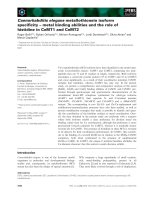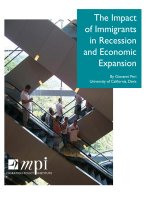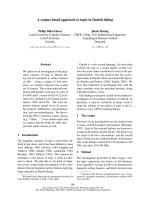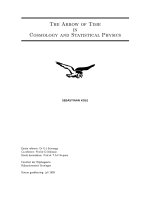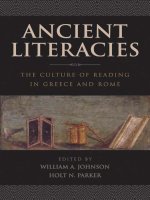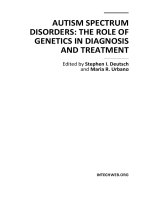The gulf of mexico oil spill a corpus based study of metaphors in british and american media discourse 4
Bạn đang xem bản rút gọn của tài liệu. Xem và tải ngay bản đầy đủ của tài liệu tại đây (2.59 MB, 60 trang )
133
CHAPTER 4
METAPHORS IN AMERICAN MEDIA DISCOURSE:
NEW YORK TIMES & WASHINGTON POST
4.1 Introduction: Metaphorical Evaluation in American Media
Discourse
Thompson and Hunston (2000) define “evaluation” as an overarching
term of reference for the text producer’s “stance towards, viewpoint on, or
feelings about the entities or propositions that he or she is talking about” (p.5).
This attitude specifically refers to sets of values that encompass notions of
“certainty or obligation or desirability”. The idea of evaluation itself is
significant as it is seen as the lens through which the world is looked upon, or
in other words, a device for interpreting what is perceived and defining what is
transmitted to others. Bednarek (2006) goes a step further to claim that these
“short term evaluations” eventually become “long-term values which are as
important to our lives as our beliefs” (p.4). The concept of evaluation is key as
the main aim of this thesis is to examine the range of metaphors framing the
Gulf of Mexico oil spill from large representative corpora of selected British
and American broadsheets. This is significant as the evaluations and
metaphors generated in these popular mainstream broadsheets aid the reader in
organising the events and the roles of the various actors when taken in
aggregate. The IICM will be used as the theoretical framework to mine the
relevant metaphors inductively and empirically, through the use of two leading
concordancing programmes as springboards for the analysis - WMatrix and
134
Sketch Engine. It is important to note that while the range of metaphors
obtained from these 250 articles per broadsheet might not be wholly
encompassing, I believe that this preliminary aggregate metaphorical analysis
done via the IICM-framework surfaces the relevant core evaluative trends
pertaining to the issue under study.
Van Dijk (1988b, p.140) states that news is “read and understood in
social situations featuring norms, values, goals and interests that are socially
shared”. News is seen as a type of written discourse that is controlled by a pre-
determined range of possible topics for news discourse. These categories
include national politics, international politics, violence, disasters, sports, art,
science and human interest. In the case of the BP Oil Spill, the national and
international dimensions of the disaster are brought to the fore due to the
potentially explosive socio-political context where a British-based company’s
negligence has resulted in widespread economic and ecological damage to
America, an established international ally. This simply means that the
potentially ethno-centric dimension of the conflict will be foregrounded as the
news values (e.g. the shared negativity, recency, proximity, unambiguity,
unexpectedness, relevance, superlativeness and facticity of the event) serve to
colour the entire catastrophe in an emotionally charged backdrop (Bell, 1991).
The metaphorical portrayals of key players in the BP oil spill (and their
resultant evaluations) in this thesis will be examined within this socio-political
backdrop in a comparative approach.
135
4.2 Utilising the IICM: Phase One – Identifying the candidate USAS
Categories/ Lexical Items for Analysis
The IICM advocates an empirical and inductive approach to the
analysis of lexical items in a large corpus. This methodology aims to
triangulate and potentially either reinforce or provide an alternative view to the
findings of traditional metaphor discourse research that mainly relied on the
intuitive pre-selection of researcher-determined search strings as a springboard
for metaphorical analysis. This is achieved by running the NYT and WP
corpora through WMatrix for a preliminary overview of the range of semantic
categories that are statistically significant in relation to the BNC-Informative
Writing sampler. The range of top-10 statistically salient semantic domains is
captured in Figures 4.1-4.2 respectively.
Fig. 4.1
USAS Semantic Tagset (A snapshot of the Top-10 semantic domains for the NYT-Corpus)
Fig. 4.2
USAS Semantic Tagset (A snapshot of the Top-10 semantic domains for the WP-Corpus)
For the purpose of explicating the IICM-framework, we will be analysing the
following USAS semantic categories that are empirically suggested by
136
WMatrix and are comparatively salient across both corpora. The four
empirically suggested USAS domains for further analysis are shown in the list
below. The corpus and the accompanying rank within the semantic domain are
captured in the accompanying brackets after the semantic domains.
1. Substances & Materials: Liquid (NYT_1/WP_1)
2. Speech: Communicative (NYT_2/WP_2)
3. Damaging and Destroying (NYT_5/WP_5)
4. Green Issues (NYT_11/WP_7)
It is important to note that while WMatrix provides an empirical
suggestion pertaining to the possible conceptual domains for further analysis,
the core factor of analyst judgment remains necessary – especially in the
selection of domains and the specific lexical items in the broad-list for further
metaphorical analysis. However, this explicit commitment to empirical
evidence as a common starting point for the subsequent extrapolation of
conceptual metaphors will enable other researchers to base their disagreements
on the same theoretical platform with respect to the same set of evidence, thus
potentially resulting in increased methodological uniformity in the metaphor
analysis procedure. This also further facilitates the ensuing discussions on the
findings in the target discourse.
137
4.3 The American Perspective: An overview of significant metaphor
types and the interaction of metaphor categories in the NYT-
Corpus and the WP-Corpus
According to PEJ (2010), the narrative in the American press focused
on BP’s culpability and agency in the lead-up to the catastrophic spill as well
as the way its executives responded to the aftermath. BP’s lack of remorse (as
demonstrated by its lack of transparency in its estimates of the damage), the
many public-relations gaffes of its then-CEO, Tony Hayward, as well as its
inadequate immediate response to the needs of the Gulf residents accounted
for most of the negative media coverage. Other economic and legal
repercussions as a result of these measures included a 50% loss in value of BP
shares, the initiation of possible criminal and civil charges against BP
pertaining to the spill, the resignation of Tony Hayward as BP’s chief
executive and the promotion of his subsequent replacement, American Robert
Dudley.
For this analysis, the focus will be placed on the linguistic choices and
patterns utilised by the selected broadsheets, devoting attention specifically to
the evaluative connotations and the implications of salient metaphorical
expressions. This is significant as the choice of these mainstream broadsheets,
with pronounced liberal or conservative leanings, influences a broad aggregate
spectrum of opinions embodied by the range of identified conceptual
metaphors. Thus, these broadsheets are chosen as a representative sample of
the popular mainstream press in an attempt to delineate the overall editorial
perspectives.
138
4.3.1. The American Perspective: An aggregate view of significant
metaphors in the NYT-Corpus and the WP-Corpus
Table 4.1 provides an aggregate view of the issue metaphorically
embodied by the NYT-corpus and the WP-corpus. All the conceptual
metaphors were identified and formulated using the IICM.
Table 4.1
An aggregate internal comparison of significant metaphors in American Broadsheets (NYT &
WP)
Key Target Domains
NYT
(Types/ Tokens)
WP
(Types/ Tokens)
THE OIL SPILL
WAR/ CRIME/CONFLICT
56.1%
54.9%
54.1%
53.6%
BP/ OIL INDUSTRY
DEBTOR/CRIMINAL / ENEMY/INCOMPETENCE/ PRAGMATIC
OPPORTUNIST/RECKLESS/ OUTDATED/ GREEDY/
(PERSONIFICATION: NEGATIVE)
25.6%
31.9%
21.1%
22.8%
BP/ OIL INDUSTRY
FIGHTER/ CONTRITE CHILD/ SCAPEGOAT/ ENTREPRENEUR/
PHILANTHROPIST/ COSMOPOLITAN ENTITY/ INVITED GUEST/
ACQUITTED DEFENDANT/VICTIM/PREY
(PERSONIFICATION: POSITIVE)
10.6%
10.4%
14.4%
16.2%
THE US GOVERNMENT/ OBAMA ADMINISTRATION
CRIMINAL/ INCOMPETENT
(PERSONIFICATION: NEGATIVE)
21.8%
21.4%
16.5%
15.4%
THE US GOVERNMENT/ OBAMA ADMINISTRATION
COMPETENT LEADER/ EFFECTIVE LAW ENFORCER
(PERSONIFICATION: POSITIVE)
13.9%
7.5%
10.1%
10.4%
These aggregate findings uncover a range of interesting ideological
differences. The NYT-corpus couches most of its metaphors in the CONFLICT
scenario, with the metaphors of WAR, CRIME and THREAT taking on a
significant 56.1% of the entire range of 51 identified metaphor types for the
selected node words. On the other hand, the WP-corpus embodies the more
conservative, pro-business view with the CONFLICT scenario making a
comparable majority of 54.1% of the total number of 55 metaphor types. This
is due to the predominant reference to BUSINESS and POLITICS as WAR or as a
GAME OF STRATEGY in the WP-corpus. Taken at face value, these statistics
seemingly contradict the corresponding metaphorical portrayal of the key
139
figures in the oil spill. In the NYT-corpus, BP is portrayed as the primary
antagonist with 31.9% of the total number of metaphors tokens presenting BP
in a negative, non-sympathetic light as a CRIMINAL, ENEMY, RECKLESS
PERSON, UNSCRUPULOUS BUSINESSMAN, INCOMPETENT PERSON,
MISBEHAVING CHILD, UNTRUSTWORTHY or UNACCOUNTABLE PERSON. Only
10.4% of the total number of metaphors in the NYT-corpus portray BP in a
sympathetic view as a VICTIM OF PARTISAN POLICIES, a COMPETENT
PROBLEM SOLVER or a RESPONSIBLE CORPORATE CITIZEN. This preliminary
pattern seems to indicate a more nationalistic editorial stance adopted by the
NYT-corpus – as most instances of the WAR/CRIME/THREAT conceptual key
make a direct antagonistic reference to BP. This is in contrast to the WP-
corpus where BP’s agency in the spill is hedged by the overarching reference
to BUSINESS and POLITICS as a WAR/GAME OF STRATEGY that necessitates a
certain degree of political and social compromise, underscored by rational
cost-benefit analysis, rather than in direct reference to BP’s culpability.
As mentioned earlier, the data sample seems to indicate that the WP-
corpus advocates a more balanced view of BP with a non-sympathetic
portrayal taking up a significantly lower 22.8% of the identified metaphors
and a sympathetic portrayal of BP taking up a more significant 16.2%. This
seems to indicate that the pro-business range of pragmatic sentiments takes
prominence in the WP-corpus. Understandably, both broadsheets portray the
various branches of the US Government/Obama Administration in a negative
light – with the main difference embodied by the NYT-corpus - where there is
an additional negative attribution of current policies and government
machinations to the previous Bush administration. I will now proceed to
140
analyse some significant metaphorical patterns and embodiments in
accordance to the metaphor classifications.
4.3.2. The American Perspective: An analysis of the interaction of
metaphor categories in the NYT-Corpus and the WP-Corpus
The identified metaphors are divided into four categories. The first
three categories are derived from Lakoff & Johnson’s (1980) seminal work,
comprising Structural Metaphors, Ontological Metaphors and
Orientational/Spatial Metaphors. The final category is Image/Analogy-
based Metaphors (Gibbs, 1999; Lakoff, 1992). Taken in tandem, these four
categories of metaphors cover the full spectrum of metaphors in the target
discourse. The statistical distribution of these metaphor categories across both
corpora is captured in Tables 4.2-4.3 below.
Table 4.2
An overview of the Metaphor Type Distribution in NYT
NYT-Corpus (158 Types out of 291, 566 words)
Metaphor Types
Types
Distribution (%)
Structural Metaphors
18
11.4%
Ontological Metaphors
114
72.2%
Orientational Metaphors
6
3.8%
Analogy-Based/Image Metaphors
20
12.7%
Table 4.3
An overview of the Metaphor Type Distribution in WP
WP-Corpus (164 Types out of 293, 519 words)
Metaphor Types
Types
Distribution (%)
Structural Metaphors
19
11.6%
Ontological Metaphors
112
68.3%
Orientational Metaphors
22
3.0%
Analogy-Based/Image Metaphors
13
13.4%
It is interesting to note that the NYT-corpus and the WP-corpus have
comparable metaphorical densities. The NYT-corpus has a marginally lower
141
metaphorical density of 158 metaphor types out of 291, 566 words whilst the
WP-corpus contains 164 metaphor types out of a slightly larger base of 293,
519 words. Much like Semino’s (2002) study on the metaphorical
representations of the euro in British and Italian newspapers, this seems to
indicate a fundamental similarity in metaphorical usage between the two
American broadsheets. This can also be attributed to the “mutual influences
between reports” due to the extensive scope of the disaster. In line with our
commitment to empirical salience, this analysis will be structured mainly in
accordance to three of the more statistically significant categories, namely
Ontological Metaphors, Structural Metaphors and Analogy-Based/Image
Metaphors.
According to Lakoff & Johnson (1980, p.25) & Kovecses (2002, p.37),
ontological metaphors provide much less cognitive structuring for concepts
than structural metaphors but they assign a tactile link to objects and
substances for conceptual concretization. A prominent sub-type falling into
this category would be that of Personification Metaphors. Lakoff & Johnson
(1980, p.34) state that personification “allows us to make sense of phenomena
in the world in human terms on the basis of our own motivations, goals and
characteristics”, thus making it a powerful explanatory tool to structure
abstract concepts to the masses. On the other hand, Gibbs (1999, p.32) defines
Image and Analogy-Based Metaphors as those used when mental images or
core embodiments from one source of knowledge is mapped onto the target
domain, rather than a systematic inter-domain mapping e.g. the reference to an
“hourglass figure”. This seems to indicate that only a specific aspect of the
source domain is used to structure the target concept rather than that of a
142
structured cognitive mapping. The analysis for this chapter will begin with a
focus on Ontological Metaphors as they comprise a significant proportion of
the metaphor count in the NYT-corpus (72.2%) and WP-corpus (68.3%)
respectively.
Structural Metaphors refer to the typical cross-domain metaphors and
similes in the traditional form of conceptual metaphor where an abstract
concept is understood by the structure of the source concept (Lakoff &
Johnson, 1980, p.3; Koveces, 2002, p.37). Taken in tandem, these conceptual
metaphors demonstrate their connections to political affiliations and the
resultant evaluative stances within the targetted newspaper corpus. Thus,
structural metaphors play a significant role in structuring the text-consumer’s
world-view when consumed in the aggregate. The IICM framework
empirically demonstrates the statistical salience of certain conceptual
metaphors found within the selected corpora. These differences are essentially
gleaned from the use of “lexical and phraseological units in their socio-
pragmatic contexts” through the IICM framework (Musolff, 2004, p.9). The
specific semantic and potentially metaphoric connotations of the specific
lexical and phraseological units are determined through the use of two leading
online versions of corpus-based dictionaries, namely the Macmillan Online
Dictionary and the Collins Online Dictionary. This forms a core step prior to
the formulation of the actual range of conceptual metaphors. This core step
essentially reflects the commitment to empirical discourse data as the basis of
any elicited claims on the metaphorical concepts that underlie the discourse.
The analysis for this chapter will take the following structure:
143
• A comparative analysis of the portrayal of BP and the Obama
Administration in the context of foregrounding American nationalistic
interests in the NYT and WP-corpus (“Damage”/ “History”/
“Rhetoric”/ “Environment”)
• A comparative analysis of the pre-eminence and the nature of the
WAR/CRIME/THREAT conceptual keys in the NYT and WP-Corpus
(“Oil_Modifies”)
4.4. The Power of Political Affiliations: The portrayal of BP and the
Obama Administration in the American Broadsheets.
One of the most pervasive metaphorical types in the NYT & WP-
corpus is one where the key protagonists (e.g. BP, the Obama Administration,
the US Government) are personified or presented as animate beings or living
entities. Overall, the most salient personification sub-type within both corpora
will be the foregrounding of BP as a key player within the
WAR/CRIME/THREAT scenarios. In the most empirically salient semantic
domain in the NYT Corpus (Substances and Materials: Liquid_NYT_1: Oil),
the overwhelming portrayal of BP is couched within the CRIME/
RECKLESSNESS/ INCOMPETENCE/ ERRANT CHILD scenario, comprising a
significant 31.9% of the NYT-corpus metaphor tokens. This contrasts with the
22.8% of the range of metaphor tokens found in the corresponding WP-
Corpus. A good example of the associated evaluative prosody in the NYT-
corpus with the node word (“Oil”) can be seen in Texts 4.1-4.2 below. In
accordance to the proposed IICM, the node word and the collocation
144
(“Company”) are empirically suggested by the word sketch function in Sketch
Engine.
4.4.1. The Power of Political Affiliations (Substances and Materials:
Liquid_1_NYT: ‘Oil’)
Text 4.1.
NYT-Corpus – Screenshot for “Oil Company” in SkE
Text 4.2.
NYT-Corpus – Screenshot for “Oil Company” in SkE
Text 4.1 shows how “oil companies” like BP are portrayed as having a
“stranglehold on American policies and behaviour”, resulting in the “choking”
of the American working peoples’ social and economic futures. The lexical
item - “stranglehold” - is defined by the Macmillan Online Dictionary as “the
strong power over someone or something that prevents them from having any
freedom to act” on top of the literal definition of a “tight hold around
someone’s neck that makes breathing difficult”. The deliberate and strategic
use of this ontological metaphor, personifying BP and other giant corporations
as POWERFUL FOREIGN AGGRESSORS directly threatening the survival of
145
American citizens is aimed at striking a chord with the text consumer. This is
attributed to the way BP is de-legitimised from its place in American society,
by being portrayed as a foreign intruder that disrupts and destroys an ordered
universe. An associated schema would be the inability of the US
government/Obama Administration to enforce order despite American citizens
being made recipients of violent material actions - such as being placed in a
potentially fatal stranglehold. This is further reinforced by the way the direct
reference to physical violence is merely countered by President Obama merely
“speaking critically” about the cozy relationship between the oil companies
and the federal government. This implies that instead of taking the necessary
action to restore order, the Obama Administration is more concerned about
shifting blame and claiming the moral high ground through the use of religious
allusions. The irony in President Obama’s attempt at distancing his own
agency from the issue can be seen in the way he separates the actions of the
“federal government” from that of his own administration in a veiled reference
to the inherited failings of the previous Bush Administration. This culminates
in the reference to religious values where the “unholy alliance” between the oil
corporations like BP turns democratically elected officials from the Bush
administration into subservient “handmaidens”. The disturbing voluntary
emasculation of the federal government and their shameless worship of
mammon mutually reinforce the resultant overarching and overlapping
conceptual metaphors portraying BP and government agencies as
ACCOMPLICES and INCOMPETENT entities.
Text 4.1 clearly demonstrates the strong anti-business, anti-Republican
leanings from the metaphors mined from this extract. The pervasive
146
underlying metaphor that “THE BUSH ADMINISTRATION IS A CORRUPT
LEADER” is further reinforced in Text 4.2 where President Obama clearly
attempts to portray himself as an effective leader who identifies strongly with
his constituents but yet is willing to “shoulder the responsibility” in times of
duress. However, the strong anti-Republican slant can be demonstrated in the
way it was clearly mentioned that it was the Bush administration that “fostered
a cozy, sometimes corrupt relationship with the MMS”. This is reinforced by
the semantic connotations of the core lexical units “cozy”, “corrupt” and
“unholy alliance” in the Macmillan and Collins Dictionary where the concept
of dishonest, illegal, and immoral activities take precedence in the pursuit of
money, power and other benefits. Attribution was also directly placed on BP
who is portrayed as the “owner of the stricken well”. The attribution of agency
for the disaster is made complete when Birnaum, the head of the MMS was
made to step down and attribute the cause of the disaster to the “flaws in the
current system (Birnaum) inherited”, in a thinly veiled reference to the
practices of the previous Bush Administration.
4.4.2. The Power of Political Affiliations (Substances and Materials:
Liquid_1_WP: ‘Oil’)
In a clear contrast, the more conservative WP-corpus overtly attributes
agency of the spill to the Obama Administration’s mismanagement and
foregrounds the interconnected portrayals of BP as both a positive agent of
economic change as well as the victim of partisan politics. Text 4.3 clearly
tears down the hyperbolic claim by the Obama Administration that “Bush did
147
it” while foregrounding the idea that Obama’s own interior secretary had
worked diligently to solve the problem “from the day he took office”. The
WP-article clearly traces the sequence of events to April 2009 where the
Obama Administration’s Interior Department provided a “categorical
environmental exemption” for BP, thus positioning the Obama Administration
as at least partially culpable. The explicit agency attribution in this short
extract is aimed at dispelling the myth of polarity, where the Obama
administration is seen to be absolving itself from all responsibility in order to
mitigate its own failure at containing the spill. This is clearly encapsulated by
the innovative phraseological unit “the buck stops”, adapted from the
traditional expression “passing the buck”. This encompasses the core idea that
the Obama administration should not make someone else deal with something
that his administration should take responsibility for, foregrounding the
ontological metaphor that personifies the Obama administration as an
INCOMPETENT LEADER who “passes the buck”, cedes control and who lacks
foresight and specialist knowledge.
Text 4.3.
WP-Corpus – Screenshot for “Oil Giant” in SkE
148
Text 4.3 acknowledges the limitations faced by both Bush and Obama,
as they cannot be held accountable for the damage caused by unforeseen
forces of nature or by unheralded acts of negligence by others. This view is
further tempered by acknowledging the unrealistic expectations placed upon
the “presidential cult of personality” inherent in the nature of American
politics. However, a particular frame for evaluation is evoked with the
reference to Obama’s lack of modesty as well as his superlative prior claim
that his ascent to the presidency will be the moment when “the planet began to
heal and the rise of oceans began to slow”. Hence, the overarching metaphor
seems to point towards the portrayal of Obama as a SHREWED POLITICAL
TACTICIAN and INCOMPETENT LEADER pushing away responsibility at a
crucial juncture
Text 4.4 demonstrates how the WP-corpus foregrounds the opposite
end of the political spectrum, highlighting the pragmatic political and
economic costs of pursuing “justice” and full compensation at all costs.
Text 4.4
WP-Corpus – Screenshot for “Oil Giant” in SkE
The extract in Text 4.4 claims that in the process of justifying an all-
out war against BP in an effort to exonerate his administration’s failings,
Obama is in fact on the brink of threatening the interests of an entire nation
(Britain), often seen as a staunch ally in matters of international policy.
149
Obama’s deliberate reference to BP’s old name, “British Petroleum” (instead
of the revamped “Beyond Petroleum”) is derisively perceived as “rabid
denunciations” and a mindless demonstration of “Anglophobic spite”,
attributed to the actions of a man floundering for political survival. According
to the Macmillan Online Dictionary, the expression “rabid denunciations”
denotes a “very strong public criticism of someone or something” or
“behaving in an unreasonable way in order to make a change”. Thus, the
ontological reference to the Obama Administration being an “UNREASONABLE
PERSON” and a “LEADER WITHOUT FORESIGHT” is foregrounded. This is done
in tandem with the clear portrayal of BP as a VICTIM OF PARTISAN POLITICS,
being “continuously beaten up on the airways” by a vicious bully, in spite of
its significant contribution to both the American and British economies.
Hence, an explication of the statistical differences in the range of
Conceptual Metaphors identified in Table 4.1 seems to be demonstrated by the
overarching political affiliations that undergird the selected ontological
representations. In the NYT-corpus, the recklessness of the oil industry (BP)
as well as the failings of the previous Bush Administration were prominently
highlighted, comprising 36.4% of the entire range of ontological metaphors in
the NYT-corpus. This can be seen in the range of conceptual metaphors mined
from the IICM (BP/THE OIL INDUSTRY IS AN UNSCRUPULOUS BUSINESSMAN,
THE OIL INDUSTRY IS AN UNREPENTANT CRIMINAL/ CORRUPT PERSON, THE
BUSH ADMINISTRATION IS A CORRUPT LEADER). On the other hand, the data
from the WP-corpus seems to foreground the pragmatic political and business
costs of blindly castigating BP, a major player in the cornerstone oil industry.
This can be clearly seen in the way the altruistic claims of the Obama
150
BP IS A CORE
CONTRIBUTOR TO THE
ECONOMY
(THREAT)
BP IS A VICTIM OF
PARTISAN
POLICIES
(THREAT)
THE US GOVERNMENT IS A
LEADER WITHOUT
FORESIGHT
(INCOMPETENCE)
SCENARIO: THREAT/ INCOMPETENCE
THE OIL INDUSTRY IS
A UNSCRUPULOUS
BUSINESSMAN
(THREAT)
AN UNHOLY
ALLIANCE IS A
CORRUPT
BUSINESS
RELATIONSHIP
THE BUSH ADMINISTRATION
IS A CORRUPT LEADER
(CRIME)
*Analogical Metaphor:
CORRUPT OFFICIALS ARE
HANDMAIDENS
SCENARIO: CRIME/THREAT
administration are questioned against a very different background of facts that
emphasises the significant role played by BP in both the American and British
economies.
Figures 4.3-4.4 demonstrate the pictorial representation of the range of
conceptual metaphors discussed in this section, mined from the selected
abstracts from Texts 4.1-4.4 arranged in a coherent framework. These pictorial
representations are essentially an adaptation of Grady, Taub & Morgan’s
(1996) proposed diagrammatic representations of compound and primitive
metaphors. It is proposed that such a diagrammatic representation will provide
a pictorial grasp of the overarching entailments and the range of conceptual
metaphors employed in the analysis of this target discourse. This classification
essentially refines CMT by organising potentially sprawling metaphorical
complexes into a coherent framework.
Fig 4.3.
Pictorial Representation of Metaphorical Primitives and Compounds (NYT-Corpus) – “THE
OIL INDUSTRY IS A THREAT” (adapted from Grady, Taub & Morgan, 1996)
Fig 4.4.
Pictorial Representation of Metaphorical Primitives and Compounds (WP-Corpus) – “THE OIL
INDUSTRY IS A THREAT” (adapted from Grady, Taub & Morgan, 1996)
151
4.4.3. The Power of Political Affiliations (Damaging and Destroying_5
_NYT: ‘Damage’/ ‘Collapse’)
Figure 4.5 below provides a quick overview of the range of
collocations for the node term “economic damage” and “reputational damage”
in NYT. This set of amalgamated collocations is empirically suggested by the
word sketch function embedded in Sketch Engine. All 13 instances generated
are captured in Figure 4.5 below:
Fig. 4.5.
Collocates for ‘Damage’ (NYT Corpus) – ‘Economic’/ ‘Reputational’ in Word Sketch (All 13
instances – Modifier/ PP-to-i)
It is important to note a significant nine out of thirteen concordance lines
contain a pejorative view of BP, seemingly simultaneously evoking and
foregrounding negative evaluations of BP’s actions. This is captured by the
metaphorical portrayal of BP as an UNSCRUPULOUS BUSINESSMAN who would
offer “quick $5000 settlements in exchange for waivers of future liability”,
references to BP’s irreversibly damaged reputation as well as the many
references to the historically unprecedented extent of the damage. Hence, a
preliminary view of this excerpt suggests the delegitimisation of BP’s status as
152
a “responsible corporate citizen”, exploiting the subconscious emotional
associations in the readers in the pursuit of justice for the aggrieved. This
amalgamated concordance excerpt seems to embody the generally nationalistic
stance foregrounded by the NYT-corpus in the framing of this issue.
The seemingly overtly partisan stance adopted by the NYT-corpus is
effectively encapsulated in Text 4.5:
Text 4.5.
NYT-Corpus – Screenshot for “Collapse” in SkE
A distinctly pro-Obama/anti-Bush stance is foregrounded in Text 4.5.
This is clearly seen in the critical reference to the Bush Administration’s
“shambolic response to Katrina”, even attributing the current “collapse in
government competence and effectiveness” to the “Bush years”. The poignant
invoking of the analogy-based metaphor (THE BP OIL SPILL IS THE NEW
HURRICANE KATRINA) serves to exploit the traumatic emotional associations
only shared by the Americans. This projects a particularly powerful
representation of the extent of Bush’s failure, particularly with the core
reference to the lack of organisation and incompetency that is entailed by the
lexical items, “shambolic” and “collapse” in competence. The intertwined
metaphorical portrayal of the Bush Administration as an INCOMPETENT
153
LEADER and that of BP as a RECKLESS CRIMINAL who failed to take “adequate
precautions” simultaneously works to mitigate the Obama Administration’s
agency in the spill, legitimising his continued leadership of the country. This
pro-Obama stance is further demonstrated in the illogical separation between
the Obama Administration and the “federal regulators (Minerals Management
Service)”.
Text 4.6.
NYT-Corpus – Screenshot for “Damage” in SkE
Text 4.6 above foregrounds Obama’s “well-intentions” and downplays
his culpability in the entire saga, thus potentially affecting the reader’s views
of the situation. Instead of castigating the Obama Administration’s gullibility
and rightfully attributing the cause of the tragedy to multiple government
oversights, Text 4.6 distills the entire issue in to a “single biggest mistake”:
that of Obama’s “default assumption” that all parties are as “well-intentioned”
as he is. This is embodied by his “failure to challenge BP’s version of events
from the start”. The lexical item “failure” in this context specifically denotes a
milder situation where a person does not do or fulfill what is expected. This
textured portrayal is especially powerful as it simultaneously serves to
154
foreground the endearing aspects of Obama’s personality while graciously
acknowledging his shortcomings (i.e. that Obama makes mistakes just like any
normal person). It also serves to over-simplify the agency in the disaster by
attributing it to the foreign company cast in the role of the “other”. This is
done through the persistent metaphorical portrayal of BP as an UNREPENTANT
CRIMINAL and UNSCRUPULOUS BUSINESSMAN who consistently “understated
the spill’s severity, overestimated the progress of the repair operation and low-
balled the environmental damage”. According to the Macmillan Online
Dictionary, the lexical items “understate” and “overstate” have the connotation
of making concessions with regards to the “truth, accuracy or importance” of
the stated topic, underscoring the personification of BP as both
UNSCRUPULOUS and UNREPENTANT. This is juxtaposed by the underlying
discourse that promotes the castigation of BP while highlighting Obama’s
redeeming qualities as a leader and as a person.
Finally, Text 4.7 expresses the full-blown anger and disappointment
experienced by the American general public over BP’s actions. The
“widespread public outrage” as well as the general “condemnation” leveled
upon BP is aimed specifically at “dramatizing events and polarizing contrasts
in order to emphasise the newsworthiness of the contents of the article”
(Semino, 2008, p.31). The repeated casting of BP into the role of the
UNSCRUPULOUS BUSINESSMAN and UNREPENTANT CRIMINAL serves to
reinforce this conceptualization of reality where the confrontational aspects of
the issue are unabashedly foregrounded such as the “widespread public
outrage”, defined as “a strong feeling of anger and shock at something you
feel is wrong or unfair”.
155
Text 4.7.
NYT-Corpus – Screenshot for “Damage” in SkE
Thus, Texts 4.5-4.7 foreground Chilton’s (1996) assertion that “power”
is defined as the “capability and resources, which include the discursive power
to promote and impose concepts as the basis of preferred policies
(viewpoints)” (p.6). This section has provided a brief overview of the range of
structural and ontological metaphors used in the conceptualisation of BP and
the Obama Administration and shows how specific metaphorical
representations have the potential become the naturalized view that is virtually
irrefutable over time.
4.4.4. The Power of Political Affiliations (Damaging and Destroying_5
_WP: ‘Damage’/ ‘Collapse’)
In direct contrast, an excerpt of the same node term “economic
damage” in the parallel WP-corpus showcases a different construction of the
roles played by BP and the Obama Administration. Figure 4.6 below
showcases the range of concordance lines associated with the node term
“economic damage”:
156
Fig. 4.6.
Collocates for ‘Damage’ (WP Corpus) – ‘Economic’ in Word Sketch (All 9 instances –
Modifier)
Figure 4.6 shows that four out of the available nine concordance lines
portray a positive-neutral portrayal of BP. BP is respectively personified as a
REPENTANT CRIMINAL that has “acknowledged responsibility for the
economic damages” and has made commitment to “compensate for economic
damage” and as a COMPETENT PROBLEM SOLVER in the way BP acted
“quickly enough to prevent permanent economic damage”. It is interesting to
note how the remaining concordance lines help to mitigate BP’s role by
making the generic reference to “oil companies’ liability” – in contrast to the
sole reference to BP preferred in the NYT-corpus. The remaining general
references to the resultant economic damages are also made without a direct
reference to agency, where the focus lies more on the objective quantification
of the cost without an overt evaluation on BP’s role in the entire catastrophe.
This seeming contrast in political affiliations is effectively shown in
Text 4.8 below:
157
Text 4.8.
WP-Corpus – Screenshot for “Damage” in SkE
Where the NYT-corpus seems to construct the reality where the Bush
Administration (and by extension, the Republican Party) shares equal
culpability with BP for the oil spill, the WP-corpus depicts the Obama
Administration’s “toothlessness”, as embodied in the statement that the
administration’s criminal investigation of BP “has little chance of getting
executives locked up”. Furthermore, instead of attributing agency to BP, Text
4.8 opts to castigate then-BP CEO, Tony Hayward instead, effectively
attributing the failures of the company to one rogue individual. The mitigation
of BP’s agency is also foregrounded in the perceived culpability of both
“corporations” and the “federal government”. This is a significant departure
from the ideology of the pursuit of justice at all costs advocated in the NYT-
corpus. Hence, the combined evaluative stances of making Hayward the
political scapegoat as well as the foregrounding of shared culpability (without
an overt nationalistic/xenophobic stance) seems to be a concerted attempt not
to damage the prospects of future economic collaboration between British and
American Governments. Hence, this seems to indicate that a pragmatic, pro-
business stance is advocated in these selected concordances in the WP-corpus.


